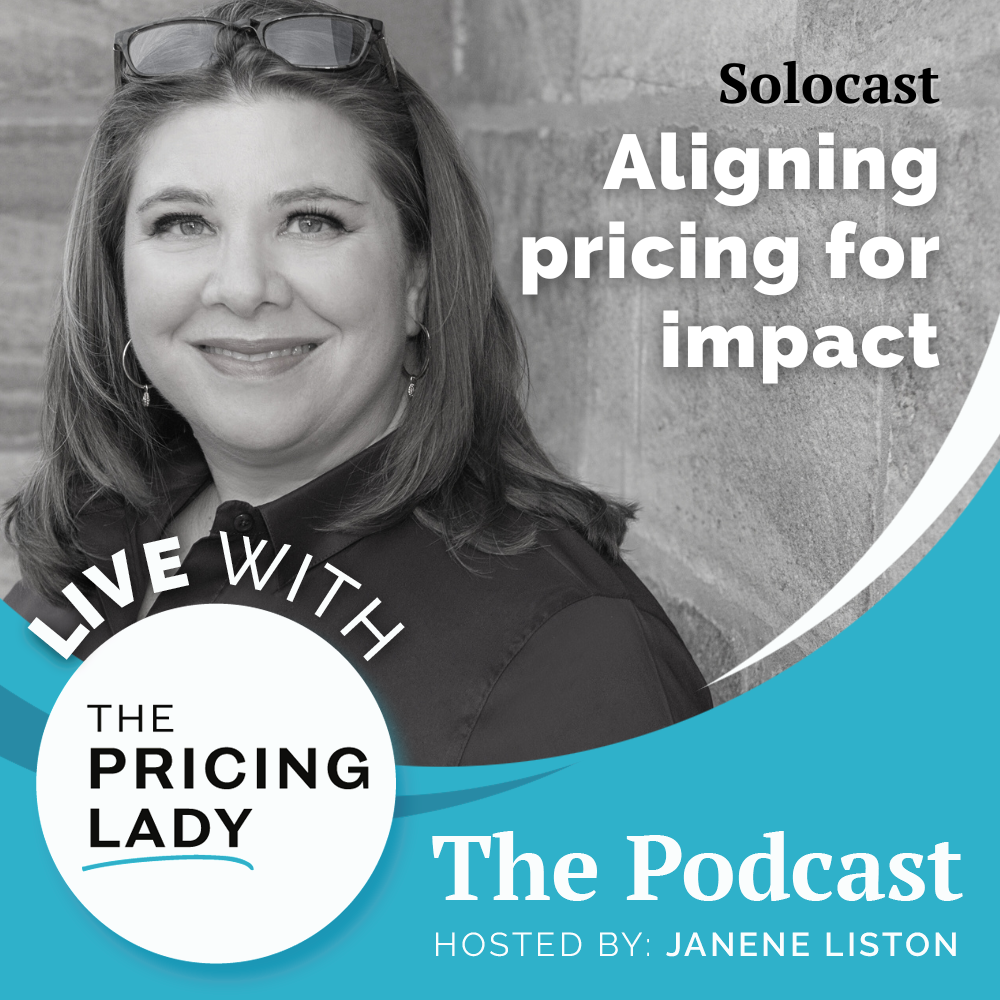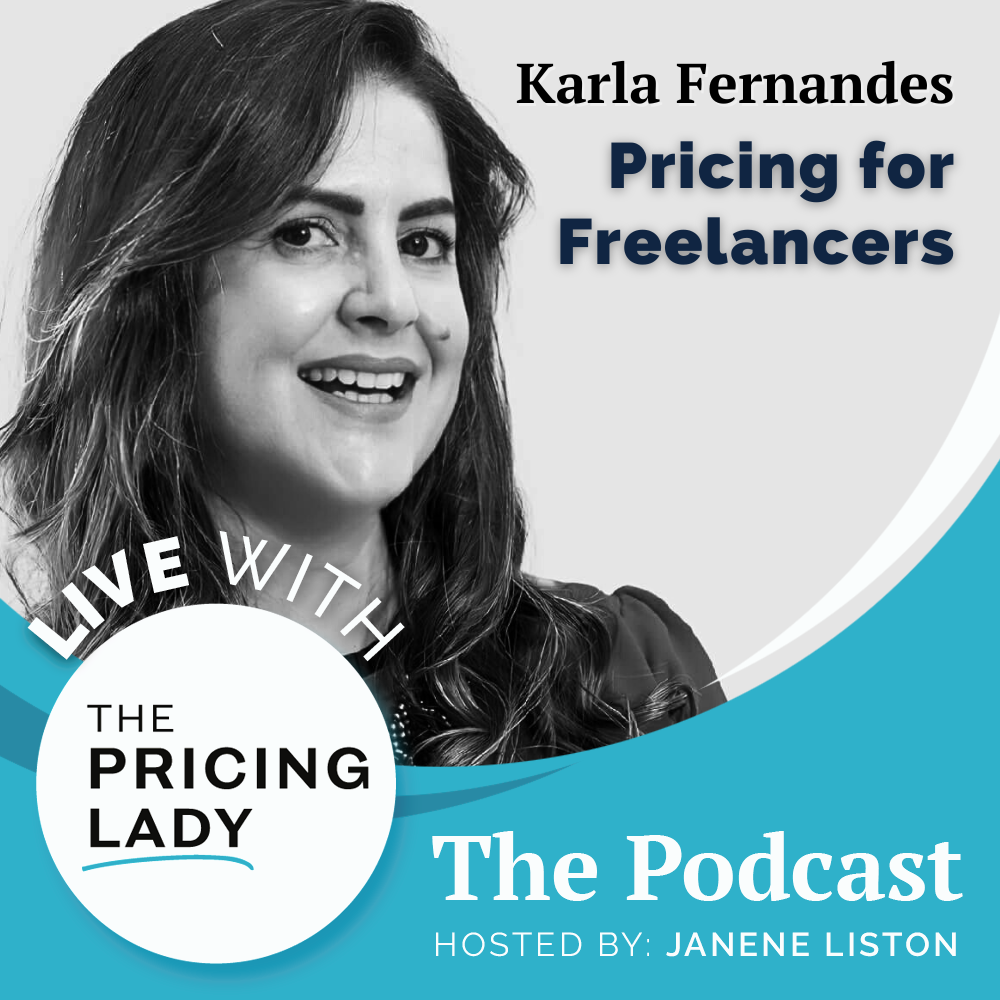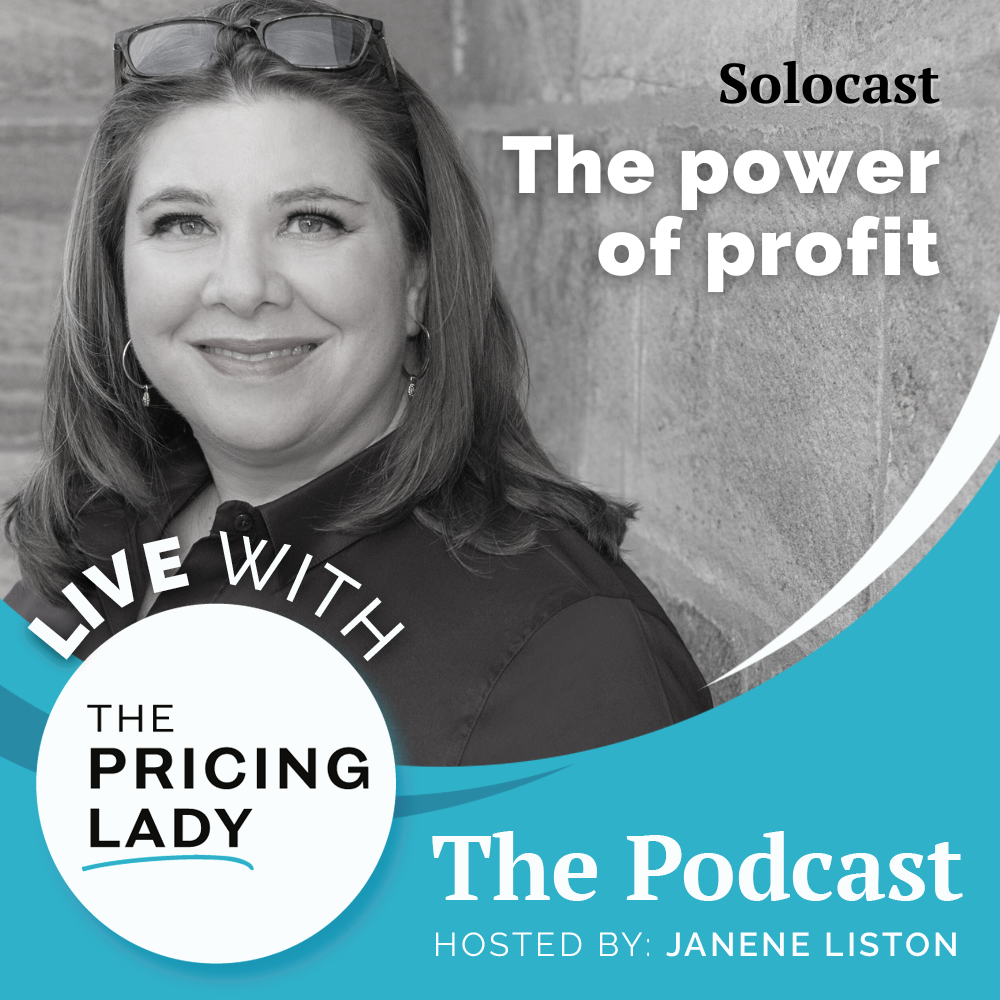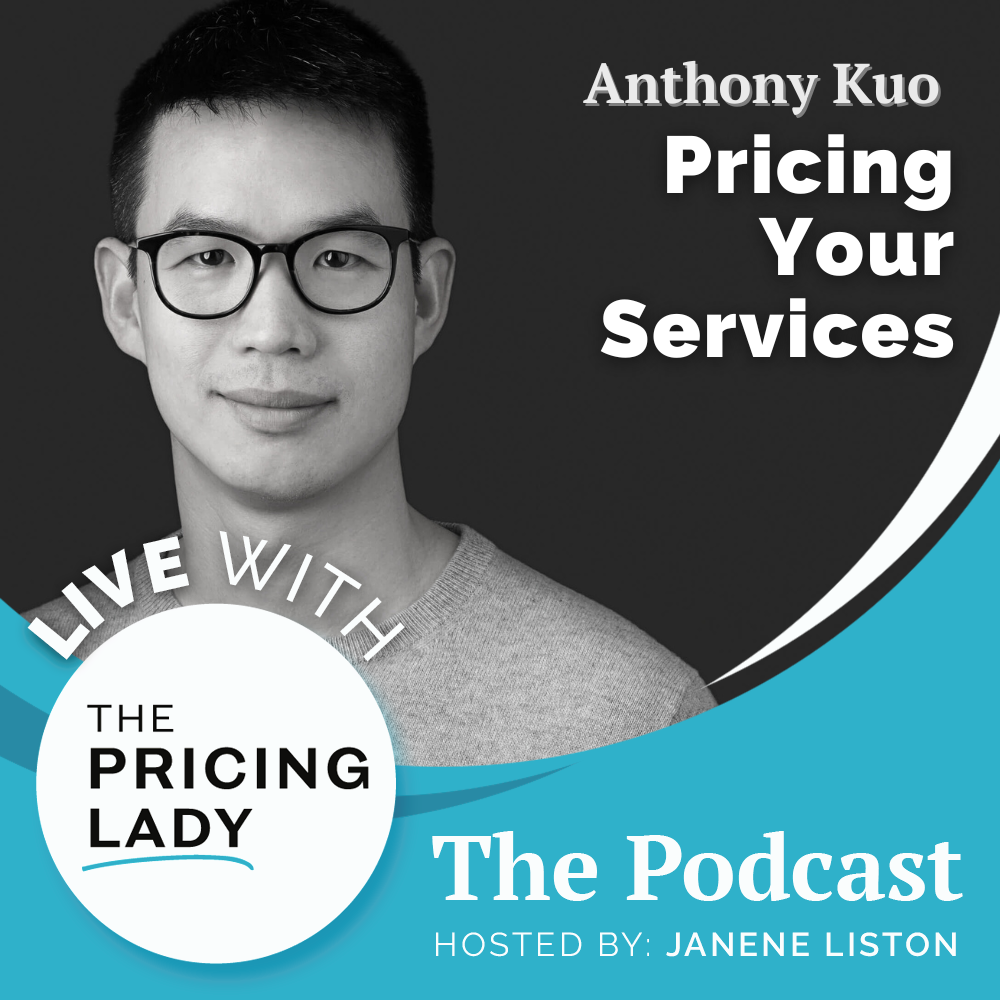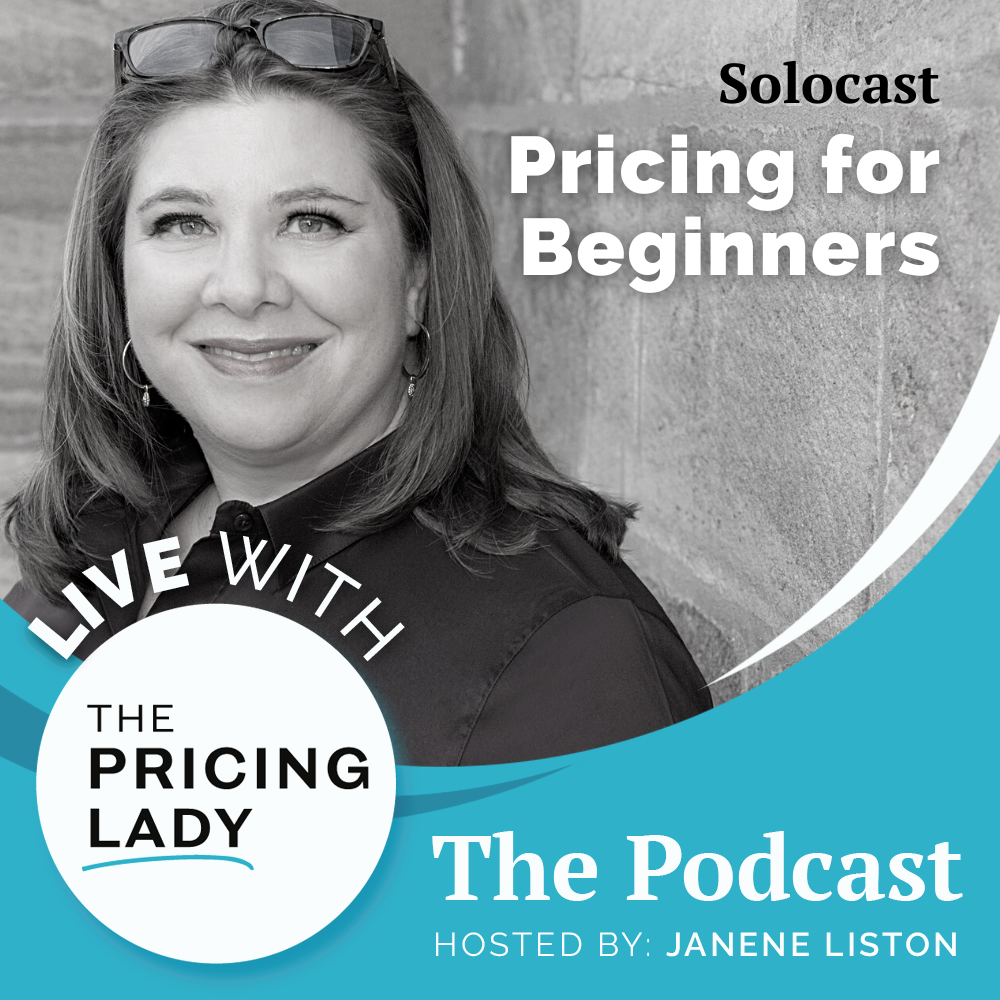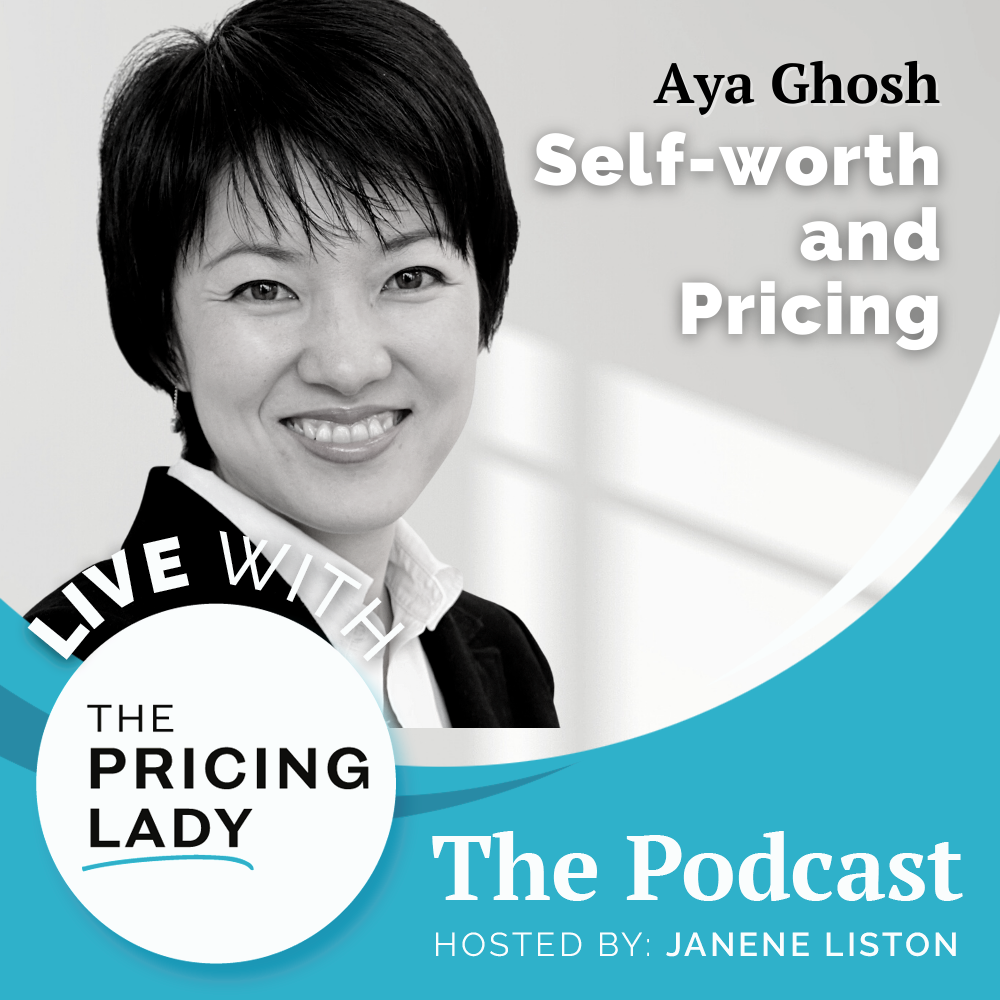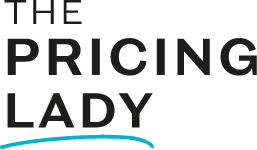Price and brand are intricately connected. Both topics drive perceptions of value and customer behavior. We’ve all encountered brands that we thought, “No way would I ever pay that.” Thinking that those who pay that much for such a thing are crazy. Then there are the brands we love, for which we will do we can to support them. There are also brands where we’ve been burned – in some way they let us down. What brands come to mind for you in each category?
Every brand has a story to tell and consumers have stories to tell about those brands. Brands are so much more than your logo and a business card or website. As a business owner you need to understand how your brand influences what people do and what they’re willing to pay. As well as how your pricing reflects upon your brand. When you understand the role they both play and the way in which they influence purchasing behavior you can build a stronger business.
In this episode…
This week on Live with the Pricing Lady I’m talking with special guest, Pete Canalichio from BrandAlive. BrandAlive is on a mission to help brands become more alive in the hearts of those that experience them. They do that by helping companies write a better story through compelling content, inspiring platform talks, in-depth consulting workshops, and practical tools.
He has interesting insights in to how brands affect our thinking and our behavior; as well as their influence on pricing. It was a real pleasure to have him on the show. Let’s take a deeper look at why we choose to pay more for the brands we love.
If your prefer to watch live stream video replay, use this link.
Highlights of this episode:
Note: these timestamps are from the video version.
- 0:00 Intro
- 1:10 Who’s Pete
- 1:54 Our relationship to brands
- 2:49 The fickleness of brand loyalty
- 5:34 Brands & willingness to pay
- 7:07 About alignment
- 9:10 Brand versus generics
- 14:04 Perception
- 21:21 The big message from Pete
- 21:58 Pete’s tip for entrepreneurs
Favorite quotes from this episode:
“If you’re a small business you can be a powerful brand. Don’t let your size make a difference in how you deliver on your promise.” Pete
“Brands want to be paid and expect to be paid a premium versus a generic, but they don’t want it to be so high or so punitive that you don’t feel like you’re getting value. The equation’s always about value. Pete
“For a luxury brand, like Tiffany’s what is the value perception? What does the little light blue box a signify? An amazing value perception. There was a whole movie made about it with Audrey Hepburn… Breakfast at Tiffany’s. The whole concept is that the diamond is way better.” Pete
“We talk about the first sale, getting somebody to buy one time is way harder than getting them buy a second time.” “Pete
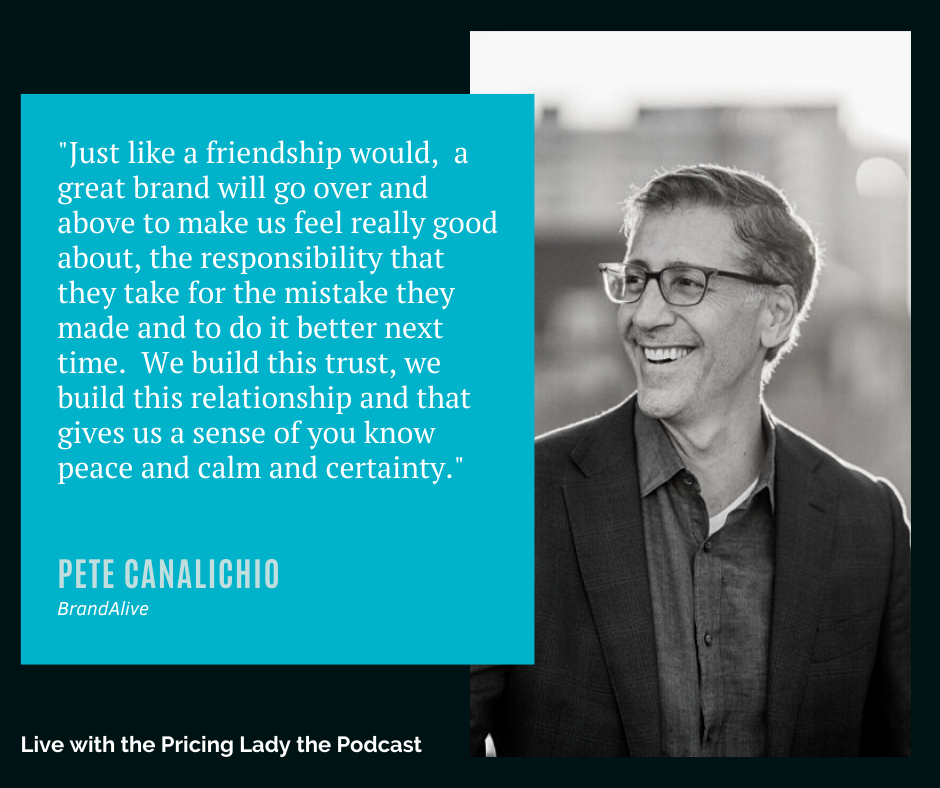
“Let’s budget airlines… just say you’re a young adult who has got a very limited budget and carries a little backpack. They don’t care (as much about comfort and perks). But for me, I needed that brand experience. And I had expectations that were never even close to being met (with a low cost airline). And I’ll never make that mistake again. Pete
“This relationship between brand and prices is really important. If we take that to small businesses, it’s just as important for a small business as it is for a big business. And sometimes small business owners, when we think of branding, we think of nice business cards and a logo. But the brand is much more than that.” Janene
Links from this episode:
Connect with Janene
Website | Linkedin | YouTube | Facebook | Email List
Get started improving your business. Sometimes it’s difficult to know where to begin. I suggest you Download the the self assessment Pricing Scorecard. Get a view of what’s working and what’s not working when it comes to pricing in your business. Figure out where to start making improvements.
Get in touch with Janene. If you’ve got a question that needs answering, a challenge you’re facing or you have suggestions for future topics or guests, let me know. Contact Janene.
Listen up! Don’t miss out. There’s a lot going on and you’ll want to be in the know. Follow my YouTube channel (rate it too please) so you don’t miss an episode of Live with the Pricing Lady or join my Email List.
Transform your business and life. My business is about helping you build a better business. One that’s profitable and where you can confidently charge for the value you deliver. Let’s see how we can work together. Book a complimentary Discovery Call today!
Episode Transcript
Pete, why don’t we start by having you tell the audience a bit about yourself.
Sure. Okay. So let me just quickly say that my background where I learned about brands is at the Coca-Cola company. I worked there for 10 years, and then after that, I had the chance to work for a company called Newell brands, which own the Rubbermaid brand. And I worked specifically on the rubber meet brand.
And then after I left there, I started my own agency brand alive back in 2009. And my goal is to help brands come alive in the hearts, that those that experienced them and, and to do that for my clients. So this is a lot of fun for me today.
Let’s Start Talking About Brands
Excellent. I’m so happy to have you here with us. So why don’t we dig into the topic a little bit more? We really want to talk about why do we pay so much more for brands? Where can we start this conversation?
Yeah. I like to talk about brands, like relationships that we have with people. Right. So think about the brands that you know, and love and, and, and, and why do you love them? Right. Well, you build a relationship with them. Over time you build trust with them, just like any personal relationship. They they deliver on other brand promise day in and day out. And if they. If for some reason they they don’t want one day, they typically take responsibility for the mistake they made, just like a friendship would, and then they make it right.
Just like a friendship would, a great brand will go over and above to make us feel really good about you know, the responsibility that they take for the mistake they made and to do it better next time. We build this trust, we build this relationship and that gives us a sense of you know peace and calm and certainty. You know, we know what we’re getting from a brand, so I’ll start with that for now.
Brand Loyalty Can Be a Fickle Thing
When I think about companies that I was, let’s say more loyal to, and then one time something went awry. Then I was like, nope, I’m off that brand. I’m out of here. You guys lost my business. It can be a really fickle thing. At times right?
Yeah, absolutely. We talk about the first sale, getting somebody to buy one time is way harder than getting them buy a second time. When I worked for the Coca-Cola company, they always talked about, a new customer was so much more expensive than getting the customer to go from one Coke a day or one Coke, or even a year to two cokes.
The fact that they, that they lost your business. I would be curious what they did and what they didn’t do to get wins your business back because, they should have known what the cost was to acquire you. You had loyalty with them. It’s not like you just had met them. And then they obviously made a major mistake in order for you to step away, which is terrible to hear.
All It Takes Is One Time to Ruin the Perception
Well, for any of those of you who are watching, who are still living here in Switzerland, you know. Pete may not know this, that customer service is different over here in Switzerland in general. If any of you are Swiss business owners, don’t I take offense to this because I am generalizing, but in general it is your honor to be a customer and to be charged for things in Switzerland.
It’s a little bit different than the United States, right? Where we expect service. Right. Yes, it is very, it is very different. And in this case that I was thinking of, it was a company that sells like electronics and they had set up this new, you know, at the time it was relatively new where you order online, but then, you can go and pick up and you know, what shop to go to and whatever it was quite convenient and nice.
Then one time I bought something. And it didn’t fit the outlet on the wall. I took it back and they said there was a 20 chf restocking fee. And I was, that was it. You know, the guy was very nice. He explained to me why that was, we don’t give you used products, you always get new. I said, yes, but I paid 60 francs for this product. Now you’re charging me with 20 francs. For a restocking fee. I just, I couldn’t, my head is just exploding.
Brands Influence Our Behaviors
We wanted to talk about why people pay so much for brands. You said that, brands are really about relationship building. How does that translate into paying, willingness to pay, interest in paying value, these types of things.
When we build the relationship with a brand what does that give us? First of all certainty. We know what we’re getting. When we have certainty, it will reduces the risk. And then there’s the positives of a relationship. It gives us prestige. If we have a brand that we regard highly the likelihood is that other people regard that brand highly as well. Even if they choose not to use it, they do see it as a premium brand.
The other thing typically with brands, they are for the most part higher quality or the performance is much higher. Right? We were talking this morning, a friend of mine, who’s another brand expert about, having a, a dinner party. You’re serving all kinds of drinks, alcoholic and non-alcoholic and you can have the choice between serving Coca-Cola or serving Big Coke.
The idea of that perception of what your friends might think about you questioning why you are serving them this off-brand or this store brand when for just 20% more, you can have the best brand in the world. Affordable luxury is the way we like to think about it.
Right.
It can play a very big role in. It’s also, it’s also interesting because… so much of it comes down to how you perceive yourself, how others perceive you, how you perceive the brand, how the brand perceives itself as well. All of these things have to come into alignment in order for you to have agreement on what the price should be. Right?
Brands Bring Image and Added Benefits (real & perceived)
It really does. And that is a bit of a, an ongoing or ever a never ending search for the exact value. For brands, they want to be paid and expect to be paid a premium versus a generic, but they don’t want it to be so high or so punitive that you don’t feel like you’re getting value.
The equation’s always about value. Even for luxury brands, like a Tiffany’s, right. What is the value perception? If somebody in and we all talk about the little in a light blue box and what does that signify? That is an amazing value perception. And there was a whole movie made about it with Audrey Hepburn.
Breakfast at Tiffany’s and the whole concept is that the diamond is way better. You don’t know exactly why you may not care about the clarity or the, you know, that the color or all those things, you just know it came from Tiffany’s and therefore it’s the world’s greatest.
And typically the person that receives that gift is, really reached a pinnacle of, the promise of what that brand stands for.
Brands Sometimes Alleviate or Reduce a Risk
Let’s look at the other side of it? How about the idea of removing risks? Let’s say I have a small child who is running a fever. In the US one of the best brands for pain relief and fever reduction is Tylenol (by Johnson and Johnson). Tylenol is known as a brand that’s very safe, very effective. Let’s just say you know, my wife asked me to run to the, to the drug store to get some Tylenol for our child. In a lot of pain, discomfort, and her fever’s going up.
I get to the drug store and I’m looking for the Tylenol. Right next to it you know, a generic version of it. I look at the ingredients and they’re exactly the same. This version is 25 or 30% less than the Tylenol. Do you think I’m going to buy that generic version? No way. I’m not going to trust the safety of my child to some brand I’ve never heard of.
Never because her safety, her comfort is paramount and I would never roll the dice on that. I’m glad to pay. I would pay 50% more, maybe even a hundred percent more under certain circumstances to have the brand. I know that’s going to make the difference. And when I give it to her, I know she’s going to feel better.
I have an interesting question for you Pete. Now, what, if you were buying that for yourself, would you consider buying the off brand.
That’s a great question. Maybe the old Pete would, but I’ve been burned enough to, and let me give you an example. Right? So, and again, apologies for those who aren’t familiar with this particular brand Tylenol. It’s acetaminophen and here in Europe, the brand is Paracetamol.
Which Airlines Do You Prefer & Why?
I’m going to switch to airline brands and so, okay. In the United States Delta airlines is a premium airline, and there’s so many things that make the Delta experience worthy of paying a premium. Let’s start with the app. The app is phenomenal. It works well.
They have a phenomenal loyalty program. When you get to there to the the airport, they have typically, great you know, a whole wing where they have all their aircraft, the gate, everything is done, the people are professional. Everything’s great. One time. I was like, okay, I’m going to save a buck.
You know, I’m going to go on this brand called spirit. Spirit airlines price is typically 50% less than Delta. I’m thinking, wow, that is great. Well, I went on and I’ll go, okay. Now let me find my seat. And I quickly realized that if I didn’t want a middle seat, then I was going to pay a premium just to be in coach.
This is aisle or window in coach. Was it another $25. And then of course I’m used to, with my status on Delta, on Delta, I don’t pay for luggage. Okay. Now there was another $25, you know, for the luggage. Oh, and did I want to carry something on. Well, that was another $25 also. And then, you know, and then the whole week experience with the gate in boarding, right.
I’m used to boarding early and getting my seat location and getting all my luggage put away. Well, now I was going to board latest and last and and the people there we’re not friendly, you know, they were not professionals. At the end of it. I don’t know that I see any money and the experience was absolutely miserable.
Again It Comes Back to the Customer & What Value They Seek
For me I learned a painful lesson. Now let’s flip it. Let’s just say you’re a young adult who has got a very limited budget and, carries a little backpack. They’re seeking something different. But for me, I needed that brand experience.
Right. I think of my dear old dad and I use him as an example sometimes. He loves it when I do this. If it’s gardening tools, there is no penny that won’t pay for something. Because that’s his thing and he loves it. But when it comes to flying, he’s right there on low cost airlines, he’d rather save the money.
I’d rather pay more, fly direct and have my aisle seat. Flying from Switzerland to California, I try to get all the way to San Francisco and then drive the rest of the way. Because I know if I stop anywhere, it’s a five hour minimum layover. I can’t stand it. I’m willing to pay more for that. Somebody else thinks, Janene’s crazy paying so much. My point is it can be dependent on what you’re purchasing.
It gets back to the comment we were making earlier around perception.
What do you perceive as value? In the case of a transoceanic flight it’s not just a better experience, but alleviating or avoiding pain. Imagine now, Janene, not only are you going to have to stop midway and have a five-hour layover, but let’s suppose you got stuck in a middle seat between two really large men?How much would pay to get moved out of that seat? There’s probably no price that you wouldn’t consider because the experience is just going to be horrific. That is something to be considered as well.
Small Businesses & the Brand Universe
It’s, true everybody’s different. The equivalent to spirit airlines over here is easy jet in Europe. People rave about it. And when I fly it, I feel miserable. I feel like I’m overpaying and being treated poorly. It’s cheap and I feel like the experience itself is so much less.
It feels like they can abuse you because you’re paying you’re not paying very much. And that drives me nuts. This relationship between brand and prices is really important. If we take that to small businesses, it’s just as important for a small business as it is for a big business.
Sometimes small business owners, when we think of branding, we think of nice business cards and a logo. But the brand is much more than that. It’s about the way that you are and the way that you want to be perceived by people. There’s a very strong relationship between that and the price that you can charge.
Yeah, a hundred percent. I talk about brand universes. Where the consumer, the fan, the enthusiast whatever you want to call the person gets to enter that universe stay as long as she wants and leave when she wants, always be welcome, she can venture into any part of that universe she wants to venture into and have the same experience.
It’s the experience that she has with me. The feeling that she can trust that I’m always going to have her best interests at heart, that I am going to give her high value for what I’m offering to her. And that, she’s going to be able to get as much information and maybe even more from me then send somebody you might actually you know, work for a big large organization. All of that makes a huge difference.
Sustainability Has Bigger Influence than Ever on Brands
A business like Nespresso or Coca-cola how does sustainability or environmental waste and how affects their brands. That’s a big discussion for coffee drinkers and Nespresso, because they have these little pods, these aluminum pods aren’t necessarily recyclable. What does that kind of thing do to a brand?
Yeah. So we were talking a little bit before the show started Janene about, you know, the whole idea of brand story, right. And about the whole part that,what we talk about in branding is your brand promise and position. The promise is what you, you deliver on each and every day. And then you want to tell your story about where you came from and what matters to you. And we buy on our why, right. We buy based on what we believe is our purpose. And we look for organizations that share that same why, that same purpose, right?
Lets say for you, as an individual, sustainability is really important. Then it doesn’t matter that Nespresso is a phenomenal, great tasting cup of coffee that’s delivered conveniently. If the, if the rest of the promise, doesn’t align with the rest of the expectations. If you’re about sustainability now, let’s just say this Nespresso has figured out a way to recycle all their pods, then you might consider it.
Your Brand Can Be Rooted in Or Simply Embrace Certain Concepts
Let me give you an example, cause I know Coca-Cola so well and I’ve worked with them on many Olympic games. Back when we were always working with them on a 2010 Olympic. Olympics in Vancouver, we talked about, I was helping sell helping organize and sell all their licensed merchandise. This was t-shirts and caps and plush and pins.
One of the things that was really important to Coca-Cola was to get out the message that all of the, all of the apparel that we created was made from recycled plastic bottles. We would literally have on the jacket or the shirt or the pants, a little logo of the bottle with a number in it.
If it was on a t-shirt, it might say eight, which meant that it was made from a plastic bottles or if it was a jacket, I might say 27. So the idea that they would convey, Hey, we care about the planet too, but we’re not going to diminish the quality of your experience, whether it’s the beverage or the overall experience that you’re getting at this Olympic games.
And by the way, this apparel, it looks beautiful and it wears great and it’s breathable and all these things. You don’t have to give up anything, but we care about the planet. That was really, in fact, we were given to worldwide while well world wildlife fund WWF as part of the whole thing too.
So of course you have, the sales went to that. So that is really important in the story is getting that part right.
Whether Big or Small Everyone Should Aspire to a Brand that Matters
For a lot of smaller businesses these days, they’re, you know, cause I’ve worked with a lot of startups. I see their desire to utilize those types of things as a very strong element in their branding. That I haven’t necessarily noticed in smaller businesses in the past, at least not in the same volume and numbers. Let’s put it that way.
Yeah. Small businesses should care. Just as much about their brand perception as large ones. I mean, for me, I live brands, right? Every day it’s important. I talk about everything communicates and that you need to communicate with ruthless consistency. If I look at my universe and I see something, I have a line that really bothers me and I have to get it right immediately.
I mean, everybody who has a brand who aspires to have a brand that matters should be thinking about that. That’s a critical part of the equation. So yeah, I would say if you’re a small brand you can be a powerful brand and don’t let your size make a difference in how you deliver on your promise. Yeah. Excellent point. Excellent point.
Parting Words From Pete
Well, Pete, I need to start wrapping things up here. What’s one thing that you’d really like people to remember from our conversation today? I would say the one thing that you should remember is that brands matter and people gladly pay more for that value that you’re going to deliver. Don’t ever think that it doesn’t, everything communicates. Make sure that you think about your whole brand universe and deliver on your brand promise wherever your consumer comes or wherever your enthusiast comes. She deserves that and you want to give it to her. Okay, fantastic. Thank you for that. One more or two more questions.
The next one is, if you go back and think about when you first started your business and the journey that you’ve been on, what’s something that you wish you knew then that you didn’t, but you know, now? Yeah, that’s a great question. I wish I would have realized then that this journey is a long one and it’s an enjoyable one. . Every little perceived setback is actually a part of the overall experience that makes my business richer and my experience better. Enjoy everything along the way it’s worth it. Yeah. Excellent. Thank you so much.

